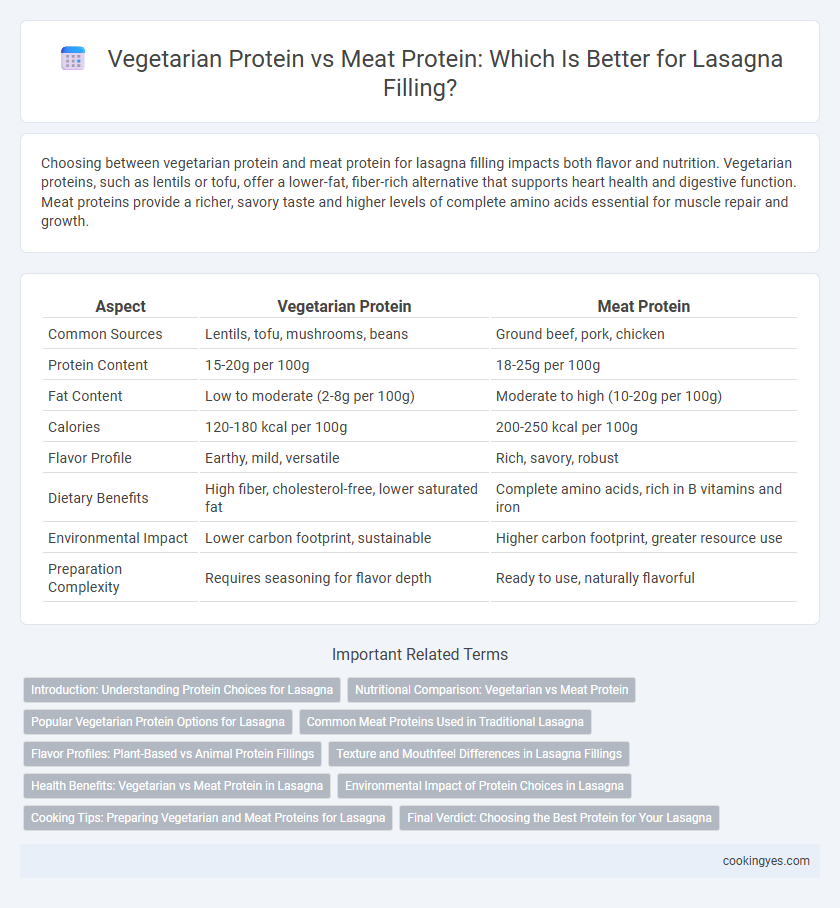Choosing between vegetarian protein and meat protein for lasagna filling impacts both flavor and nutrition. Vegetarian proteins, such as lentils or tofu, offer a lower-fat, fiber-rich alternative that supports heart health and digestive function. Meat proteins provide a richer, savory taste and higher levels of complete amino acids essential for muscle repair and growth.
Table of Comparison
| Aspect | Vegetarian Protein | Meat Protein |
|---|---|---|
| Common Sources | Lentils, tofu, mushrooms, beans | Ground beef, pork, chicken |
| Protein Content | 15-20g per 100g | 18-25g per 100g |
| Fat Content | Low to moderate (2-8g per 100g) | Moderate to high (10-20g per 100g) |
| Calories | 120-180 kcal per 100g | 200-250 kcal per 100g |
| Flavor Profile | Earthy, mild, versatile | Rich, savory, robust |
| Dietary Benefits | High fiber, cholesterol-free, lower saturated fat | Complete amino acids, rich in B vitamins and iron |
| Environmental Impact | Lower carbon footprint, sustainable | Higher carbon footprint, greater resource use |
| Preparation Complexity | Requires seasoning for flavor depth | Ready to use, naturally flavorful |
Introduction: Understanding Protein Choices for Lasagna
Choosing between vegetarian protein sources and traditional meat protein for lasagna fillings impacts nutritional value and flavor profile significantly. Plant-based proteins like lentils, tofu, and chickpeas offer high fiber content and lower saturated fat levels compared to beef or pork, making them heart-healthy alternatives. Meat proteins contribute essential amino acids and a rich, savory taste that defines classic lasagna, while vegetarian options provide versatility for dietary preferences and sustainability.
Nutritional Comparison: Vegetarian vs Meat Protein
Lasagna fillings with vegetarian protein sources like lentils, chickpeas, or tofu offer comparable protein content to traditional meat-based options, often with lower saturated fat and cholesterol levels. Meat protein, such as ground beef or pork, provides complete amino acid profiles but tends to be higher in calories and saturated fats, which can impact cardiovascular health. Incorporating plant-based proteins in lasagna enhances fiber intake, antioxidants, and essential micronutrients, promoting better digestion and overall nutrient density.
Popular Vegetarian Protein Options for Lasagna
Popular vegetarian protein options for lasagna filling include tofu, tempeh, lentils, and textured vegetable protein (TVP), each providing a rich source of plant-based protein and a texture that complements layers of pasta and sauce. Lentils offer a hearty, earthy flavor and are high in fiber and iron, making them a nutritious alternative to ground meat. Tofu and tempeh absorb the flavors of herbs and tomato sauce well, enhancing the overall depth and protein content of vegetarian lasagna.
Common Meat Proteins Used in Traditional Lasagna
Traditional lasagna filling commonly features meat proteins such as ground beef, Italian sausage, and veal, which provide rich flavors and a hearty texture. These proteins contribute essential amino acids and fats that enhance the dish's mouthfeel and depth. In contrast, vegetarian proteins like lentils, tofu, or tempeh offer plant-based alternatives but often differ in texture and umami intensity compared to classic meat options.
Flavor Profiles: Plant-Based vs Animal Protein Fillings
Vegetarian protein fillings in lasagna, such as lentils, tofu, or mushrooms, offer a rich umami flavor with earthy and nutty notes that complement tomato sauce and herbs. Meat protein fillings, typically ground beef or sausage, provide a robust, savory taste with a fatty richness that enhances the dish's overall depth. The contrast in flavor profiles highlights plant-based fillings' lighter, more herbaceous qualities versus the hearty, intense flavor of traditional animal proteins.
Texture and Mouthfeel Differences in Lasagna Fillings
Vegetarian protein sources like lentils, tofu, and textured vegetable protein offer a softer, often creamier texture in lasagna fillings, creating a moist and cohesive mouthfeel. Meat proteins, such as ground beef or pork, provide a denser, chewier bite with a more robust and fibrous texture that contrasts against the pasta layers. These textural differences significantly influence the overall sensory experience, with vegetarian options delivering tenderness while meat fillings impart a hearty satisfaction.
Health Benefits: Vegetarian vs Meat Protein in Lasagna
Vegetarian protein sources like lentils, beans, and tofu provide high fiber content and essential nutrients beneficial for heart health, while reducing cholesterol levels compared to meat protein. Meat proteins, such as ground beef or pork, offer complete amino acids but are often higher in saturated fats and calories, potentially increasing cardiovascular risks. Choosing plant-based fillings in lasagna supports lower inflammation and improved digestion, contributing to overall long-term health benefits.
Environmental Impact of Protein Choices in Lasagna
Vegetarian protein sources like lentils, mushrooms, and tofu used in lasagna fillings significantly reduce greenhouse gas emissions compared to traditional meat protein such as ground beef or pork. Cultivating plant-based proteins requires less water, land, and energy, making it a more sustainable option for environmentally conscious consumers. Choosing vegetarian protein for lasagna not only lowers the carbon footprint but also supports biodiversity and helps mitigate deforestation associated with livestock farming.
Cooking Tips: Preparing Vegetarian and Meat Proteins for Lasagna
To achieve the best texture and flavor in lasagna filling, cook ground meat such as beef or pork until browned and fully crumbled, seasoning with garlic and Italian herbs for depth. For vegetarian protein options like lentils, tofu, or textured vegetable protein (TVP), saute with onions and spices until tender and well-flavored to mimic the savory profile of meat. Draining excess moisture from both meat and vegetarian proteins prevents a watery lasagna, ensuring a firm, cohesive filling layer that bakes evenly.
Final Verdict: Choosing the Best Protein for Your Lasagna
Vegetarian protein sources like lentils, tofu, and mushrooms offer a nutrient-dense, lower-fat alternative to traditional meat proteins such as ground beef or pork in lasagna fillings. These plant-based proteins provide fiber, antioxidants, and essential vitamins while maintaining a rich texture that complements the layers of pasta and cheese. Choosing the best protein depends on dietary preferences and nutritional goals, with vegetarian options excelling in heart health and sustainability, whereas meat proteins deliver higher complete amino acid profiles and richer flavor intensity.
Vegetarian Protein vs Meat Protein for Lasagna Filling Infographic

 cookingyes.com
cookingyes.com